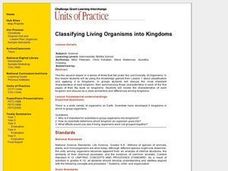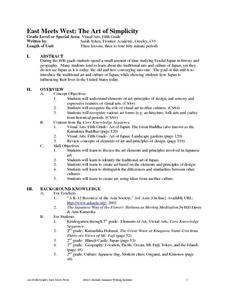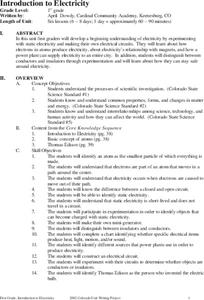Curated OER
Students Get Animated: Make Existing Lessons Move and Motivate Students
Students study the chemical elements in a computer generated cartoon format. In this computer animation and chemistry lesson, students learn how to animate using computer programs. Students use animation to learn about the Periodic Table...
Curated OER
Getting Animated
Learners create a simple animation illustrating a chemical element in the periodic table. In this chemistry lesson plan, students create a new way to describe elements by using them in an artistic form.
Curated OER
Investigating Linear Equations Using Graphing Calculator
Students investigate linear equations using the Ti-Calculator. In this algebra lesson, students graph lines and identify the different quadrants on a coordinate plane. They identify ordered pairs used to plot lines.
Curated OER
Fractions
Fifth graders, after inventorying, add up the numerators of their fractions to see if it is the same number as the denominator. If it is, then they are ready to build whatever they wish, but using only what is in their individual inventory.
Curated OER
Graphing and the Coordinate Plane
Students gain practice reading coordinates and plotting points by participating in the Coordinates! Game. They demonstrate and test their skills with graph paper and the Maze Game.
Curated OER
THE CAPTAIN'S JOURNAL
Pupils imagine themselves as the captain of the CSS Alabama and they are to stop all Yankee traffic, taking prisoners and sinking merchant ships. They write a couple of paragraphs stating their view of the purpose of the CSS Alabama.
Curated OER
Classifying Living Organisms into Kingdoms
Learners create a flip book that describes the basic characteristics of the five main animal kingdoms. They research the animal kingdoms, include examples of organisms for each kingdom and illustrate the finished text.
Curated OER
The Basis for Our Moral Code (Judaism and Christianity)
Students consider the history and significance of the Judao-Christian culture through this nine lesson unit. Scenes from the Old and New Testaments are reenacted as students unearth some of the foundations of our Western Culture.
Curated OER
When Germs Attack!
Students explore the hidden world of microbes and how our bodies spring into action in response to diseases. This ten lesson unit presents data on several microbial diseases and the reaction of the body's immune system.
Curated OER
From Sea to Shining Sea
Students study the geography of the United States of America. Students write letters, create travel brochures, make maps, graph population numbers, read fiction and nonfiction selections, complete KWL charts, and watch films.
Curated OER
The Human Body
Students explore human growth and development as they participate in class activities, reading and discussion. Worksheet and handouts are included in the lesson.
Curated OER
East Meets West: The Art of Simplicity
Fifth graders examine the influences of Japan on American life through this three lesson unit. Feudal Japan with its traditional arts and culture is contrasted with current developments of the country.
Curated OER
Roman and Early Christian Art
Third graders explore pattern, texture, balance, symmetry as they examine Roman and Byzantine art in the four lessons of this unit. Details of the major art works studied are placed into a booklet for presentation to the class.
Curated OER
Levers and Pulleys and Gears, Oh My!
Students explore the difference between compound and simple machines in this six lessons of this unit. The purpose and importance of a variety of types of simple machines and the effects of friction are investigated.
Curated OER
Second Graders Create Their Own Social Studies Book (Part I, The 5Ws of the Constitution)
Students develop their own social studies textbook using a blank theme book as they complete activities and learning experiences throughout the year. The activities are in art, music, simulations, read alouds, shared writing and a class...
Curated OER
Our Solar System
Students study the Earth and Solar System through a variety of activities. They compile a coloring book show the characteristics of the Sun and nine planets.
Curated OER
Getting to Know My World
Students participate in hands-on activities using maps and globes to identify geographical features. Students use map legends to identify direction. Students locate oceans, continents, countries, states and cities. Handouts and...
Curated OER
Introduction to Electricity
Students experiment with static electricity and make their own electrical circuits. Students experiment with their circuits to explore conductors and insulators. Students identify Thomas Edison as the person who invented the electric bulb.
Curated OER
Habitats of the World
Students complete a unit of eighteen lessons that cover climate, geography, location, plants, and animals of each of the five habitats. They are also introduced to habitat destruction and discuss ways to protect the environment. They do...
Curated OER
Time Travel, Black Holes, and Relativity
Students read the novel, The Time Machine, and compare H.G. Well's perceptions of the future with those presented in The Third Wave, by Alvin Toffler. They research current scientific and mathematical theories that relate to space and time.
Curated OER
Democracy: Understanding the Canadian Parliamentary System
Students study democracy, levels of Canadian government and the responsibilities of elected officials. They write letter's to the Prime Minister about their pride in Canada.
Curated OER
Heat Up the Floating Plates
Eighth graders research the connection between the convection currents within the mantle of the earth and the moving of Earth's plates. A connection to lessons at previous grade levels on the rock cycle and important background...
Curated OER
Crimes from Mother Goose
Students use Nursery rhymes in a discussion of crimes and criminals in order to study how criminal law has developed and changed to maintain an organized society. They decide on the identity of criminals, the crime, and the name of the...
Curated OER
Time Conceptualization
Students relate the number and length of generations in their living family members to the number of generations that have passed since specific events in recorded history. They then apply this time conceptualization to the number of...

























